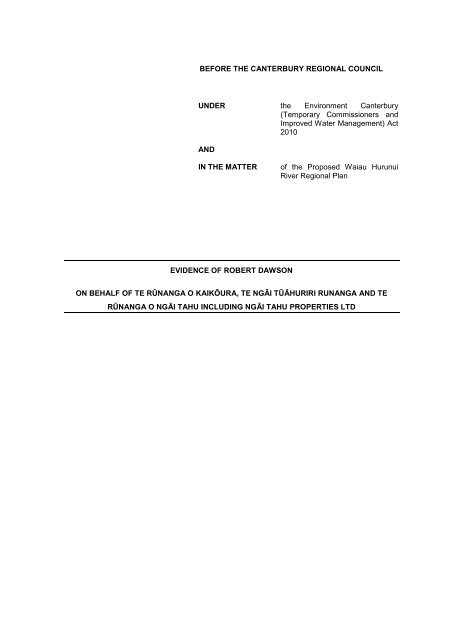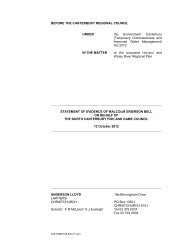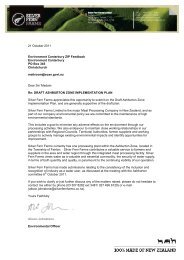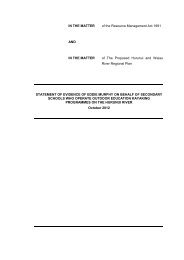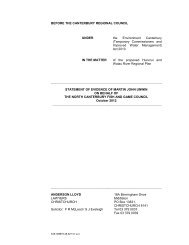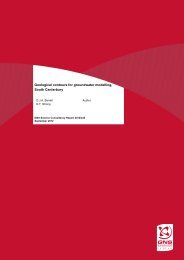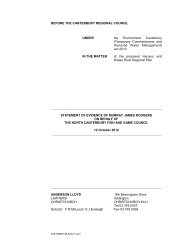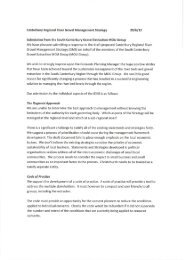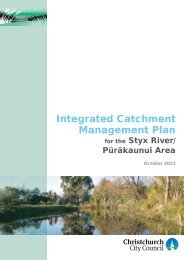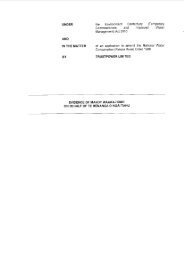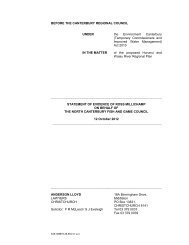Evidence of Robert Dawson - Environment Canterbury
Evidence of Robert Dawson - Environment Canterbury
Evidence of Robert Dawson - Environment Canterbury
Create successful ePaper yourself
Turn your PDF publications into a flip-book with our unique Google optimized e-Paper software.
BEFORE THE CANTERBURY REGIONAL COUNCIL<br />
UNDER the <strong>Environment</strong> <strong>Canterbury</strong><br />
(Temporary Commissioners and<br />
Improved Water Management) Act<br />
2010<br />
AND<br />
IN THE MATTER<br />
<strong>of</strong> the Proposed Waiau Hurunui<br />
River Regional Plan<br />
EVIDENCE OF ROBERT DAWSON<br />
ON BEHALF OF TE RŪNANGA O KAIKŌURA, TE NGĀI TŪĀHURIRI RUNANGA AND TE<br />
RŪNANGA O NGĀI TAHU INCLUDING NGĀI TAHU PROPERTIES LTD
2<br />
1. HE KUPU WHAKATAKI - INTRODUCTION<br />
1.1 My name is <strong>Robert</strong> <strong>Dawson</strong>. I was born in Woodend in 1946. My father is a <strong>Dawson</strong> from<br />
Ahipara, and my mother is a Karaitiana from Tuahiwi. I am here today to talk about my<br />
personal relationship with the Hurunui River.<br />
1.2 I grew up at Woodend where I learnt how to gather food by my grandfather and uncles. This<br />
includes whitebaiting and catching flounders on the Ashley, hunting possums, gathering pipi<br />
and cockles from the Ashley river mudflats, and gathering eels from Lake Forsyth, the<br />
Hurunui and creeks near Woodend. Even as children my brother Bill and I would catch eels,<br />
even with our hands.<br />
1.3 My father was the hunter. I learnt to hunt in 1955 and we would go about 3 times a week.<br />
There was no television in those days and when we got home from school we would get<br />
changed and go out to catch whatever we could.<br />
1.4 I was taught by my grandfather and uncles how to catch eel, where to catch it, when to catch<br />
it and how to prepare it. Rather than using a whata (platform) to bleed and dry eels, my<br />
grandfather would split and salt eels, and then hang them up high in the macrocarpas at his<br />
home in Tuahiwi.<br />
1.5 My earliest memories <strong>of</strong> eeling was when I would have been about 5 years old, going out to<br />
Lake Forsyth eeling before the winter. I used to love going over there with my grandfather<br />
and uncles. I used to enjoy listening to the old people telling their stories, reminiscing about<br />
the past, and the banter between them all, like who could hook the most eels. In those days<br />
I can remember the Skippers, Reuben‟s and Karaitiana‟s out at the lake.<br />
1.6 I have always loved eeling. The old man would say to us “go get some eels you fellas,” and<br />
we would go out eeling. We use to pāwhara the eels from the Ashley. We would eat eels<br />
fresh, fried, roasted, deep fried or curried. We use to eat a lot <strong>of</strong> eel.<br />
2. MY EARLY MEMORIES OF EELING<br />
2.1 The Hurunui was a special place. Although I‟ve heard stories <strong>of</strong> people from Tuahiwi going<br />
to the Hurunui eeling I‟m not sure who, how long and when. We never went to the Hurunui<br />
specifically for eeling. I guess it was too far for the old car to go, and there were other<br />
places before that where we could gather eels.<br />
2.2 My earliest memories <strong>of</strong> the Hurunui is when I used to go to the high country stations with<br />
my grandfather and uncles. In those days my grandfather was a contractor blade shearer
3<br />
and he would work in those high country stations shearing with my uncles and other men,<br />
mainly from Tuahiwi.<br />
2.3 I went shearing with my grandfather and uncles from the age <strong>of</strong> 5 until I went to boarding<br />
school in the North Island when I was 12. They would go shearing from October to January.<br />
I would go up there during the school holidays or any other time my grandfather would ask<br />
me.<br />
2.4 My grandfather would come around home and say to me “Well boy do you want to come up<br />
to the shearing shed” I would say yes and then he would tell me to go get my swag. I<br />
would spend about 2 weeks a time up there, and would be going backwards and forwards<br />
during the shearing season. Looking back on it now I guess I used to miss quite a bit <strong>of</strong><br />
school.<br />
2.5 The first farm I would have gone to would have been the Glens <strong>of</strong> Tekoa station. I also<br />
recall going to other stations like Esk Head, Islands Hill and Lake Taylor. We would go<br />
through the Hurunui and work our way all the way down to the south bank <strong>of</strong> the Rakaia.<br />
2.6 My aunties worked on the Glens <strong>of</strong> Tekoa station. My Aunty June Karaitiana was a land girl<br />
there and my Aunty Mere Karaitiana used to also work there doing all the cooking. When<br />
my uncles went out shearing my aunties looked after me who would feed me up on cakes<br />
and scones. There was always something to do. They certainly taught us to work hard. I<br />
really missed going up there when I had to go to boarding school.<br />
2.7 During our time on the high country stations eels were a major part <strong>of</strong> our diet. We used a<br />
hinaki to catch eels. We had hinakis hidden underneath all the woolsheds. So when we<br />
arrived for the shearing season we knew where the hinaki were. Then when we left we<br />
would put the hinaki back underneath the woolshed for the following year.<br />
2.8 The hinaki were usually made out <strong>of</strong> chicken netting and no.8 wire. The hinaki would be<br />
placed in the water with mutton or a sheep head in it, and we would put a sack over the<br />
hinaki it to make it dark. We would leave the hinaki in the water over night and check it the<br />
next morning.<br />
2.9 Everytime it was full <strong>of</strong> eels. You couldn‟t pull the hinaki out by yourself, it always needed<br />
two people. In those days the eels were massive. I would say about 7 kilos in size. We<br />
would only take the large eels because I think this was what the old people preferred to eat.<br />
We only took enough eels to feed everyone, so for a gang <strong>of</strong> 10 we might take 5 big eels.<br />
2.10 The eels used to be dried, split, and then cut into big steaks, and put in a roasting dish to be<br />
roasted. I can remember old Joby Skipper who used to stuff them. Joe Karaitiana who lived
4<br />
in Birdlings Flat used to stuff them and roast them. He was famous for it. They were<br />
magnificent.<br />
2.11 When I returned from boarding school I worked at the freezing works. My brother and I used<br />
to go hunting all the time. Since I knew most <strong>of</strong> the cockys they would let us hunt on their<br />
farms for pigs and deer. If we were to stay up there the night then we would take a small<br />
collapsible eel net, which could be set in a hole in the river with fresh pork and venison <strong>of</strong>fal<br />
to catch eels. I kept on hunting until about 15 years ago.<br />
3. EELING AT THE HURUNUI TODAY<br />
3.1 In 2009 I started my own commercial eeling business. When I was made redundant from<br />
the freezing works 3 years ago eeling seemed a natural thing to do as I have been doing this<br />
since I was a kid. Back in the 70s eeling was booming and I did it part-time to earn a bit <strong>of</strong><br />
extra money for the family. So I got a commercial license and quota with my friend John<br />
Spice.<br />
3.2 I am an ardent supporter <strong>of</strong> sustainable fishing and hold eel in high regard. From<br />
September through to May I eel with fyke nets. I pretty much eel most <strong>of</strong> the rivers and<br />
tributaries between the Jed River and the Waimakariri, in particular the Hurunui, Waiau,<br />
Waipara, Pahau, Lake Taylor and the Hurunui estuary. I returned to a swimming hole that I<br />
last used 55 years ago and caught 30 eels. The local cocky wanted me to eel the swimming<br />
hole because the kids didn‟t want to go swimming there because <strong>of</strong> the eels.<br />
3.3 I set up my own eel processing plant at my home in Woodend where we dry, smoke and<br />
vacume pack eel into small packs. Up until now we have been selling our smoked eel at<br />
farmers markets and boutique outlets. We enjoy selling at the markets because it gets the<br />
eel out to the local people who otherwise would not be able to obtain it. We also have the<br />
opportunity to explain how we catch, where we catch and the nutritional value <strong>of</strong> eel. Our<br />
customers love to share their childhood stories <strong>of</strong> how their parents and grandparents took<br />
them eeling in the dark with torch and spear. It brings back memories for them and we find<br />
this encouraging.<br />
3.4 We ensure that our product is processed to a very high quality, and we endeavour to provide<br />
it to the New Zealand public at an affordable price. We won the Best Food Producer from<br />
the River or Sea at the 2011 Taste Farmers Markets New Zealand Awards.<br />
3.5 Water clarity and quality is absolutely vital for the well-being <strong>of</strong> eels. An opening out to the<br />
sea is crucial so elvers can enter and swim up our rivers. The wetlands, side braids and
5<br />
tributaries are also important because eels like to be in the s<strong>of</strong>ter water, and these are also<br />
really important habitat for elvers.<br />
3.6 One <strong>of</strong> my real concerns is the quality <strong>of</strong> water within our rivers. Obviously stuff in the water<br />
can be taken into the flesh <strong>of</strong> the eel, and I need to be guaranteed that the water quality is at<br />
a level that the eels I catch won‟t be contaminated and endanger human health. This should<br />
never happen.<br />
3.7 My business and livelihood relies upon being able to sell „safe‟ eel to people. I must be able<br />
to meet food standards and for eel this means that the water quality from where the eel is<br />
harvested is important. While water quality is important from a customary perspective, it is<br />
now extremely important as my livelihood relies on clean and fresh water.<br />
4. FINAL COMMENTS<br />
4.1 I absolutely loved eeling as a child with my grandfather and uncles. When the family comes<br />
around they expect a feed <strong>of</strong> eels and I like to be able to koha eels at tangi, hui and other<br />
events.<br />
4.2 The methods that I now use are basically the same as the traditional methods I was taught<br />
except for the use <strong>of</strong> modern fyke nets. When you hunt and gather you need to be in touch<br />
with the elements. You need to look at the water, determine whether there is any tuna there,<br />
just by the habitat, the riparian margins, flax and toi toi.<br />
4.3 You take enough mahinga kai for our own needs, while passing on the resource in the same<br />
state, if not better, to your children. I have no choice in this. There is an onus on those who<br />
take water to show respect for nature, and to maintain the ecological balance.<br />
4.4 This is what I was taught and what was expected <strong>of</strong> me by my grandparents and uncles. I<br />
have a responsibility to pass on to our children and grandchildren the skills that we have, so<br />
they in turn will carry on after us.<br />
R <strong>Dawson</strong><br />
October 2012


